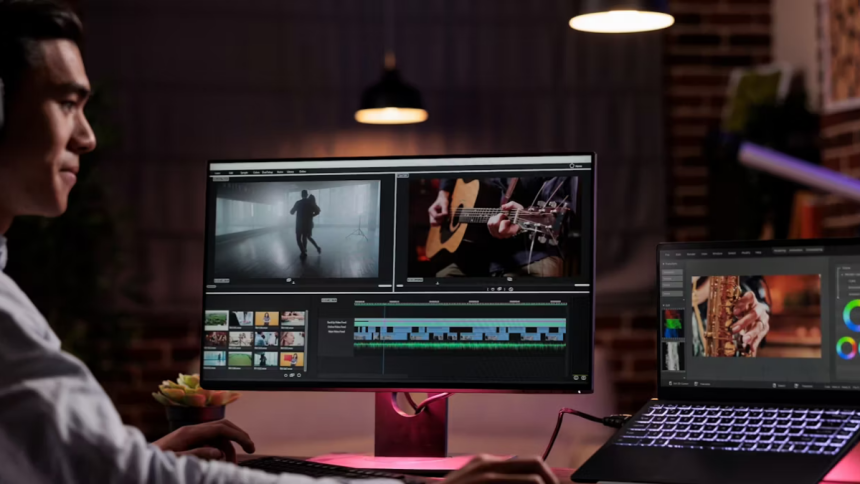Adobe Premiere Pro dominates with 35% market share, but DaVinci Resolve’s free offering and Final Cut Pro’s Mac optimization are reshaping professional workflows. This comprehensive analysis reveals that choosing between these titans depends heavily on your specific workflow needs, budget constraints, and platform preferences. While Adobe maintains its industry-standard position through ecosystem integration, competitors are challenging with superior performance optimization, transparent pricing, and specialized strengths that often outclass the market leader.
The professional video editing landscape has never been more competitive, with 2025 marking a pivotal year for software innovation driven by AI integration and cloud-first collaboration. After extensive testing and industry analysis, three platforms emerge as the clear professional choices, each with distinct advantages that serve different segments of the creative economy.
Adobe Premiere Pro: the ecosystem champion with expensive baggage
Adobe Premiere Pro remains the undisputed market leader for good reason – its deep Creative Cloud integration and comprehensive third-party ecosystem make it the safe choice for professional workflows. The software excels at handling diverse projects with its extensive codec support and seamless handoffs to After Effects for motion graphics work.
However, Premiere Pro’s dominance comes with significant trade-offs. Stability issues plague the platform, with users reporting frequent crashes when working with MP4 files in complex timelines and memory leaks during extended editing sessions. Professional editors have developed workarounds – transcoding MP4s to ProRes for stability, saving projects every 10-15 minutes, and restarting the application every 2-3 hours during long sessions.
The subscription model creates mounting costs that many professionals find unsustainable. At $22.99 monthly for Premiere Pro alone or $59.99 for the full Creative Cloud suite, the five-year total cost approaches $1,440-$3,600 before considering essential third-party plugins. Adobe’s recent introduction of AI credit limits adds another layer of complexity to pricing that feels increasingly punitive to professional users.
Technical performance struggles compared to competitors, particularly with multicam editing where Final Cut Pro handles 40 UHD streams while Premiere Pro chokes on complex multicam scenarios. The software’s poor optimization for LongGOP codecs like H.264 and H.265 forces many professionals into proxy workflows even on powerful hardware.
Where Premiere Pro truly shines is professional ecosystem integration. The Dynamic Link connection with After Effects remains unmatched for motion graphics workflows, and the extensive third-party plugin ecosystem from Boris FX, Red Giant, and others provides solutions for virtually any professional need. Industry adoption remains strong, with 85% of 2025 Sundance Film Festival entries using Adobe applications.
DaVinci Resolve: Hollywood-grade tools disrupting the market
DaVinci Resolve offers the most compelling value proposition in professional video editing – a completely free version that includes features other software charges hundreds of dollars for. Blackmagic’s strategy of giving away professional-grade editing tools to sell hardware has created a paradigm shift that’s forcing the entire industry to reconsider pricing models.
The software excels in color grading performance, maintaining its reputation as the industry standard for professional color work. The integrated Fairlight audio tools provide professional DAW capabilities with up to 2,000 tracks and advanced features like ADR tools that surpass Premiere Pro’s basic audio offerings. The all-in-one approach eliminates the need for separate applications, reducing both cost and workflow complexity.
Technical performance impresses, with better stability than Premiere Pro and superior resource utilization. Testing shows DaVinci Resolve maintains 80-95% CPU utilization during color grading operations compared to Premiere Pro’s 60-80% average. The software scales excellently with high core count processors, making it ideal for workstation-class hardware.
However, the learning curve presents a significant barrier. The interface complexity and 256-page manual reflect the software’s professional heritage but intimidate newcomers. The node-based color grading system, while powerful, requires substantial time investment to master. Many users report needing months to achieve proficiency across all modules.
Platform limitations affect adoption – while available on Windows, macOS, and Linux, the free version restricts GPU performance and collaboration features that professional teams require. The $295 Studio upgrade unlocks these capabilities but represents a significant investment for smaller operations.
The collaboration features in DaVinci Resolve Studio surpass competitors with native real-time collaboration allowing multiple editors on the same timeline. This capability alone justifies the Studio license for many professional teams, offering workflow advantages that Adobe’s Team Projects struggle to match.
Final Cut Pro: Mac-only performance powerhouse
Final Cut Pro delivers unmatched performance optimization for Apple hardware, leveraging Apple Silicon’s unified memory architecture and Metal acceleration to achieve rendering speeds that embarrass cross-platform competitors. The software consistently demonstrates 5x faster performance than Premiere Pro on equivalent Apple hardware, with background rendering keeping timelines responsive during active editing.
The Magnetic Timeline represents genuine innovation in editing interface design, preventing sync issues through intelligent clip behavior that adapts to editorial changes. Professional editors initially resisted this departure from traditional track-based editing, but many now acknowledge its workflow advantages for certain project types.
Multicam performance stands alone, handling up to 64 camera angles with smooth playback while competitors struggle beyond 8-12 angles. For documentary filmmakers and event videographers working with multiple camera setups, Final Cut Pro provides capabilities that justify platform switching despite ecosystem limitations.
The one-time purchase model offers refreshing cost predictability in an industry dominated by subscription fatigue. At $299, the total cost of ownership over five years ($3,200 including Mac hardware) compares favorably to Adobe’s subscription model. Free lifetime updates eliminate ongoing licensing concerns that plague subscription-based workflows.
However, Mac ecosystem lock-in limits professional adoption. The software’s Mac-only availability prevents mixed-platform workflows common in larger production environments. Audio capabilities remain limited compared to DaVinci Resolve’s Fairlight or Premiere Pro’s Audition integration, requiring external tools like Logic Pro for advanced audio post-production.
Color grading tools lag behind both Premiere Pro and DaVinci Resolve, with basic correction capabilities sufficient for most projects but lacking the advanced controls professionals expect. The plugin ecosystem, while robust through FxFactory, remains smaller than Adobe’s extensive third-party options.
The forgotten heavyweight: Avid Media Composer
While often overlooked in consumer discussions, Avid Media Composer maintains dominance in Hollywood and broadcast television with 60-70% market share for major film productions. The software’s superior media management and collaboration tools reflect decades of refinement in professional environments.
However, outdated interface design and steep learning curves limit broader adoption. The $199-$499 annual subscription pricing positions Media Composer as expensive compared to alternatives, while the complex workflow paradigm alienates content creators accustomed to more intuitive interfaces.
Performance reality check: hardware requirements that matter
Modern professional video editing demands substantial hardware investment regardless of software choice. 4K workflows require minimum 32GB RAM, 8GB+ VRAM GPUs, and NVMe storage delivering 1000+ MB/s sustained throughput. 8K editing pushes requirements to 64GB+ RAM and 20GB+ VRAM, making RTX 5090 graphics cards nearly essential for smooth timeline interaction.
NVIDIA maintains clear advantages in professional workflows, with CUDA acceleration providing 70% performance leads in RAW processing and dual NVENC encoders delivering up to 5x faster H.264/H.265 exports. AMD graphics cards offer competitive pricing and superior H.264 decode performance but struggle with RAW workflows that define professional production.
Apple Silicon achieves remarkable efficiency in Final Cut Pro workflows, with M4 Max chips providing performance comparable to high-end PC workstations while consuming significantly less power. However, this optimization remains exclusive to Final Cut Pro, limiting cross-platform workflow flexibility.
The collaboration and workflow efficiency gap
Modern post-production demands real-time collaboration capabilities that traditional software architectures struggle to provide. DaVinci Resolve’s native collaboration features surpass competitors, allowing multiple editors simultaneous timeline access without complex project sharing workflows.
Cloud-based collaboration through Frame.io has become essential across platforms, but integration quality varies significantly. Adobe’s partnership provides seamless review and approval workflows, while other platforms require additional software or manual processes that slow professional timelines.
AI integration is reshaping editing workflows across all platforms. Adobe’s Firefly-powered features like Generative Extend and auto-captioning provide practical productivity improvements, while DaVinci Resolve’s AI tools focus on technical optimization rather than creative assistance. Final Cut Pro’s AI features remain limited compared to competitors.
Hidden costs that destroy budgets
Professional video editing software costs extend far beyond licensing fees. Essential plugins typically add $500-$2000 annually, while hardware requirements often demand $3000-$8000 workstation investments. Training and productivity losses during software transitions consume additional resources often exceeding software costs.
Adobe’s subscription model generates ongoing expenses that compound over time, with five-year costs reaching $3600 for Creative Cloud access. Hidden charges for AI credits and cloud storage create billing surprises that professional budgets must anticipate.
DaVinci Resolve’s free model eliminates software licensing costs but requires Studio upgrade ($295) for collaboration features and advanced performance. The one-time investment provides better long-term value than subscription alternatives.
Final Cut Pro’s transparent pricing offers cost predictability rare in professional software, but platform limitations may force expensive hardware migrations or multi-platform licensing for team workflows.
Stability concerns that impact deadlines
Software stability directly affects professional productivity and deadline compliance. Extensive user reports reveal concerning patterns across platforms that professionals must understand and mitigate.
Premiere Pro suffers frequent crashes with MP4 files, memory leaks during extended sessions, and GPU driver conflicts that disrupt professional workflows. Recommended workarounds include transcoding problematic formats, regular project saves, and application restarts every 2-3 hours.
DaVinci Resolve demonstrates superior stability but becomes unreliable when minimum hardware specifications aren’t met. Insufficient VRAM causes timeline crashes, while beta versions significantly compromise reliability for production work.
Final Cut Pro maintains excellent stability on supported hardware, with crashes primarily occurring during intensive background analysis or with corrupted media files. The software’s hardware optimization contributes to its reliability advantage.
Industry adoption patterns reveal preferences
Professional adoption varies dramatically by industry segment, reflecting workflow priorities and established practices. Hollywood studios maintain loyalty to Avid Media Composer for feature films while embracing Premiere Pro for certain productions and documentaries.
YouTube creators and content professionals strongly favor Premiere Pro for its ecosystem integration and extensive tutorial resources. However, DaVinci Resolve adoption accelerates among budget-conscious creators attracted to professional features without licensing costs.
Broadcast television maintains conservative preferences with Avid dominance, though Premiere Pro gains ground in news and fast-turnaround environments where integration speed matters more than traditional workflow compatibility.
The verdict: choose based on priorities, not marketing
No single platform dominates all professional scenarios. Success depends on matching software strengths to specific workflow requirements and organizational constraints.
Choose Adobe Premiere Pro when ecosystem integration matters more than cost efficiency, when extensive third-party plugin requirements exist, or when team collaboration across diverse software platforms is essential. Accept stability compromises and ongoing subscription costs as trade-offs for industry-standard compatibility.
Choose DaVinci Resolve for color-critical work, cost-conscious professional environments, or workflows requiring integrated audio post-production. Invest time in learning curve challenges for access to Hollywood-grade tools without Hollywood-grade licensing fees.
Choose Final Cut Pro for Mac-based workflows prioritizing performance optimization, multicam editing excellence, or cost-predictable licensing models. Accept platform limitations and audio workflow constraints for unmatched editing efficiency on Apple hardware.
The professional video editing market in 2025 rewards informed choices over popular defaults. While Adobe Premiere Pro maintains market leadership through ecosystem advantages, competitors offer compelling alternatives that often exceed the market leader’s capabilities in specific areas. Smart professionals evaluate actual workflow needs rather than accepting industry momentum, finding significant advantages in platforms that major competitors underestimate.
Understanding these nuanced trade-offs enables informed decisions that optimize productivity, control costs, and deliver professional results regardless of platform choice. The best video editing software is the one that disappears into your creative process while delivering the technical capabilities your projects demand.
Lynn Martelli is an editor at Readability. She received her MFA in Creative Writing from Antioch University and has worked as an editor for over 10 years. Lynn has edited a wide variety of books, including fiction, non-fiction, memoirs, and more. In her free time, Lynn enjoys reading, writing, and spending time with her family and friends.















